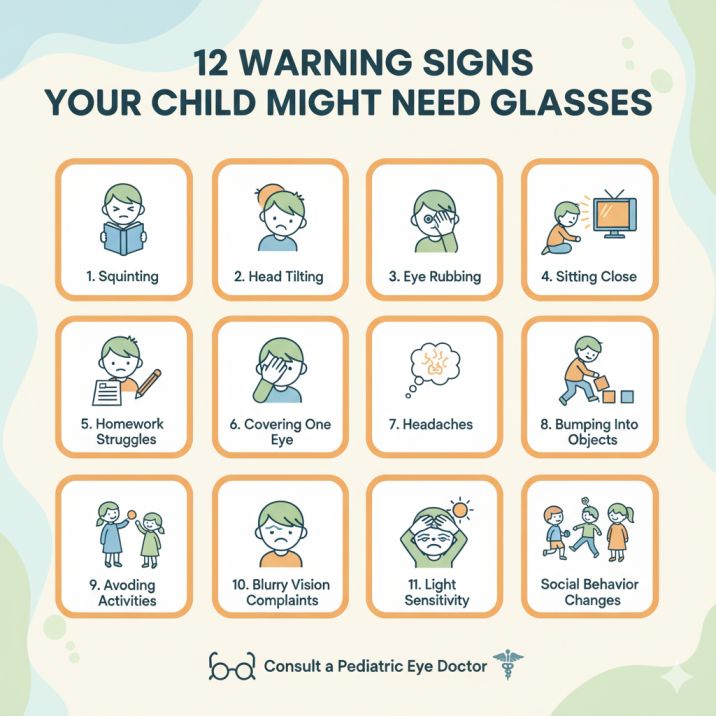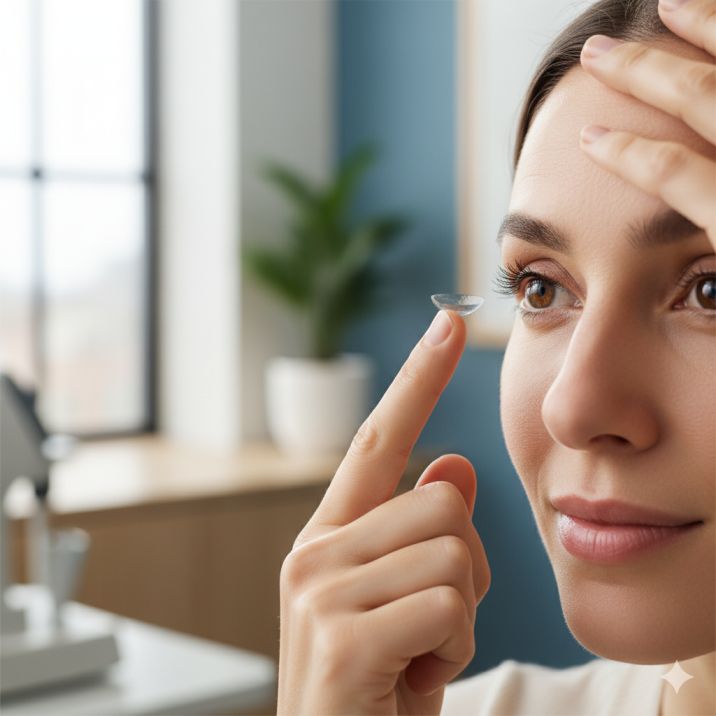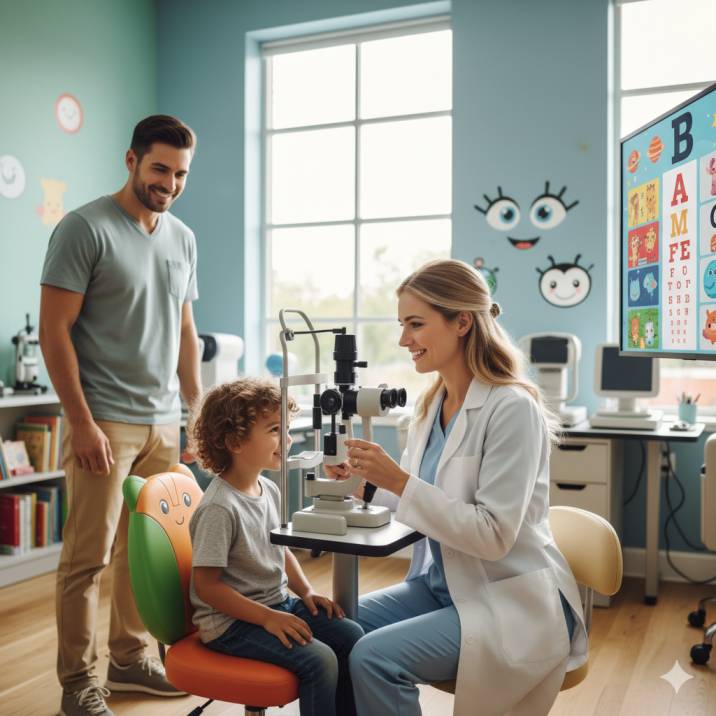Does My Child Need Glasses? Warning Signs & When to Act
Is your child squinting at the TV, struggling with homework, or complaining of headaches? These seemingly minor issues could be early warning signs that your child needs glasses—and catching them early could transform their academic success and quality of life.
As a parent in Seattle’s competitive educational landscape, you want to give your child every advantage for success. While you’re focused on the best schools, extracurricular activities, and learning opportunities, there’s one crucial element that often goes unnoticed until problems become severe: your child’s vision.
Current research indicates that approximately 6.8% of children under 18 years have diagnosed eye and vision conditions, while 1.9% experience visual impairment or blindness. Even more concerning, vision screening prevalence declined significantly from 69.6% in 2016 to 60.1% in 2020—a 13.6% decrease—amid the COVID-19 pandemic, which further reduced access to specialist care, making parental awareness more critical than ever.
The challenging reality? Children often don’t realize their vision isn’t normal – it’s simply the only way they’ve ever seen the world. That’s why understanding the subtle signs that indicate your child might need glasses could be the key to unlocking their full potential in school, sports, and social development.
Why Early Vision Detection Matters More Than You Think
Your child’s visual system develops rapidly during their first eight years of life, making early intervention crucial for proper development. During this critical window, glasses may be necessary to help normal visual development, and delayed treatment can result in permanent vision problems.
Vision directly impacts every aspect of your child’s development. Studies directly link success in school with corrected vision, while visual deficits can affect comprehension, information processing, and lead to behavioral issues affecting attention and retention. Children spend approximately 80% of their learning time using their vision, making clear sight essential for academic achievement.
The stakes extend beyond academics. Children with amblyopia are nearly three times more likely than those without amblyopia to develop vision impairment in their better-seeing eye later in life, making early detection a critical investment in your child’s long-term eye health. Recent 2024 research from University College London has revealed additional long-term implications: adults who had amblyopia as children showed 29% higher odds of developing diabetes, 25% higher odds of hypertension, and 16% higher odds of obesity, further highlighting the importance of early detection and treatment.
12 Critical Warning Signs Your Child Needs Glasses
🚨 URGENT: Schedule an Eye Exam if Your Child Shows: • Covering one eye while reading or watching screens • Frequent headaches after school or homework time
• Complaints of double vision or seeing “fuzzy” • Sudden changes in academic performance • Persistent eye rubbing during visual tasks
Recognizing the signs that your child might need glasses requires understanding both obvious symptoms and subtle behavioral changes. Here are the key indicators that warrant professional evaluation:
Physical Signs and Symptoms
1. Frequent Squinting or Blinking Squinting may indicate a refractive error, which affects how well the eyes focus on an image. When children squint, they’re temporarily improving focus and clarity by reducing the amount of light entering their eyes. Blinking more rapidly or frequently than normal is one of the common signs that could indicate an underlying vision problem in toddlers.
2. Head Tilting or Covering One Eye Your child might cover one eye or tilt their head to adjust the angle of vision in an attempt to increase clarity. This behavior often indicates eye misalignment or amblyopia (lazy eye), one of the most common eye disorders in children, affecting approximately 2-4% of children, with recent studies showing up to 4 in 100 children may be affected.
3. Excessive Eye Rubbing Excessive eye rubbing may indicate that your child is experiencing eye fatigue or strain, which could be a sign of many types of vision problems and conditions. Pay attention to when your child rubs their eyes – if it becomes a habit during reading or visual concentration, it may indicate vision difficulty.
4. Sitting Too Close to Screens or Books Sitting too close to the television, holding hand-held devices too close to the eyes, or lowering the head while reading are all possible signs of poor vision. This behavior often indicates myopia (nearsightedness), where bringing an object closer makes an image bigger and clearer.
Learning and Behavioral Indicators
5. Academic Performance Changes. Because children need to quickly and accurately adapt their visual focus from distant to near objects, ranging from chalkboards and computers to textbooks and tablets, vision problems may manifest as a lack of focus on schoolwork. Difficulty with schoolwork, including problems concentrating, can point to a need for glasses, as switching focus from close-up work to far-away work can tire out school-aged children with vision issues.
6. Reading Difficulties Reading difficulties are often misdiagnosed as learning difficulties when a vision problem is really at the root. Watch for children who lose their place while reading, skip words or lines, or complain that words are “jumping” on the page.
7. Frequent Headaches or Eye Pain If your child complains about eye pain or headaches at the end of the day, they may be overexerting their eyes in an effort to increase focus on blurred vision. Headaches while reading, doing homework, or after spending time on digital devices might indicate eye strain and a potential need for glasses.
Coordination and Motor Skills
8. Poor Hand-Eye Coordination. Frequently bumping into things, tripping, or problems with hand-eye coordination activities as catching a ball, can indicate reduced or poor vision. These issues may signal depth perception problems or general visual impairment affecting spatial awareness.
9. Avoiding Close-Up or Distance Activities Children who avoid activities requiring clear vision – whether reading, drawing, sports, or board games – may be unconsciously compensating for vision problems. This avoidance often represents their way of managing visual discomfort.
Communication Indicators
10. Complaints About Vision If a child complains that they can’t see clearly, take them seriously. Kids who complain of blurry vision could need corrective lenses. Be especially alert to complaints about double vision, which can also be a symptom of a more serious condition.
11. Light Sensitivity If your child is getting headaches when outside for some time, this can be a sign that they are photophobic (sensitive to light). Excessive tearing in bright environments or complaints about glare may indicate vision issues requiring professional evaluation.
12. Changes in Social Behavior Children struggling with vision problems may become withdrawn, avoid group activities, or seem less engaged in social interactions. These behavioral changes often stem from difficulty seeing clearly in various situations, affecting their confidence and participation.
Take Action Now
If you’ve noticed any of these signs in your child, don’t wait. Early intervention can prevent permanent vision problems and unlock your child’s full potential. The sooner vision issues are detected and corrected, the better the outcomes for your child’s academic success, social development, and long-term eye health.
Common Pediatric Vision Problems Every Seattle Parent Should Know
To better recognize when your child needs glasses, it’s helpful to understand the most common pediatric vision conditions affecting children in our region:
Refractive Errors
The most common vision disorders in children are refractive errors – myopia, hyperopia, and astigmatism, which occur when light is not focused on the retina, causing blurred vision.
Myopia (Nearsightedness): Objects at a distance appear blurry while near vision remains clear. Eye care specialists warn parents about the impending “myopia epidemic” as nearsightedness rapidly increases worldwide.
Hyperopia (Farsightedness): A condition where visual images come to focus beyond the retina, resulting in defective vision of near objects.
Astigmatism: An irregularity in the shape of the cornea or lens that causes blurry vision at all distances if not corrected.
Amblyopia (Lazy Eye)
Found in approximately 2-4% of children, amblyopia is the most common cause of vision loss in children, where vision is impaired due to abnormal development of neural connections between the brain and eye during early childhood. Recent 2024 research shows that only 14% of children receiving eye exams are 7 years or younger, despite early detection being critical. Treatment is most successful when initiated before age 7 and less effective at older ages.
Strabismus (Crossed Eyes)
Between 2-4% of children under age 6 have strabismus, a misalignment of the eyes that can lead to amblyopia development. The effect on appearance may negatively affect emotional health, social relationships, and self-image.
Age-Specific Vision Development and Warning Signs
Understanding normal vision development helps parents recognize when something isn’t progressing typically:
Infants (0-12 months)
Children are born with quite poor vision levels, with newborn visual acuity approximating around 2/60 level, developing rapidly so that by six months their visual acuity approximates 6/12.
Normal milestones include:
- Holding eye contact by 6 weeks when rested and alert
- Eyes moving together to follow objects by 8 weeks
- Fixing and following brightly colored targets with both eyes open
Toddlers (1-3 years)
The National Center for Children’s Vision and Eye Health recommends instrument-based vision screening for 1 and 2-year-olds. Warning signs include:
- Not reaching visual developmental milestones
- Continued eye turning or misalignment
- White or dull red reflex in photographs
Preschoolers (3-5 years)
Optotype-based (eye charts) or instrument-based screening is indicated for children between the ages of 3-5. Many vision problems start before children enter first grade, making early treatment crucial for school readiness.
School-Age Children (6+ years)
Children aged 6 and above should have yearly optotype-based screening focused on identifying uncorrected refractive errors. Academic performance becomes a key indicator of vision health at this stage.
Ready for Professional Care?
Ready to take the next step? Schedule a comprehensive pediatric eye examination with our experienced Seattle team, who understands the unique needs of developing visual systems. Our child-friendly approach ensures a comfortable experience while providing thorough evaluation and early intervention when needed.
When to Seek Professional Eye Care
Several situations warrant immediate professional evaluation:
Urgent Referral Needed:
- Any complaints of double vision
- White or unusual coloring in the pupil
- Sudden vision changes
- Eye pain or persistent headaches
- Significant eye misalignment
Schedule Routine Evaluation:
- Failed school vision screening
- Multiple warning signs present
- Family history of childhood vision problems
- Any parental concern about vision development
If your child fails a vision screening, the most important thing to do is to have them seen by an eye care provider for a comprehensive eye exam. Vision screening is crucial for early detection and prevention of vision loss in young children.
What to Expect During a Pediatric Eye Exam
Understanding the examination process can help both you and your child feel more comfortable:
For Younger Children
Pediatric charts have shapes or pictures on them, and if your child is too young to talk, the optometrist can check for eye conditions and determine a prescription by watching how your child’s eyes focus through a series of lenses.
For Older Children
Examinations typically include:
- Visual acuity testing
- Eye alignment assessment
- Depth perception evaluation
- Overall eye health examination
- Refractive error measurement
If your child is nervous, the exam can happen while they sit on your lap, making the experience more comfortable for anxious young patients.
The Impact of Modern Life on Children’s Vision
Today’s children face unique vision challenges that previous generations didn’t encounter. A 2024 study found that 43.5% of children examined had more than 0.5 diopters of myopia in at least one eye, while more than half (53.2%) of children aged 5-12 years had premyopia in at least one eye:
Digital Eye Strain
Our eyes were made to look into the distance, not at bright screens for hours on end. Extended screen time can contribute to:
- Increased eye fatigue
- Dry eyes
- Focusing difficulties
- Potential myopia progression
Reduced Outdoor Time
Sunlight can help prevent nearsightedness and slow progression for kids who are nearsighted. When kids play outdoors, they focus on things in the distance, relaxing the eye.
Academic Pressures
Increased near-work demands from early reading, homework, and educational screen time place additional strain on developing visual systems.
Creating a Vision-Healthy Environment at Home
While professional care is essential, parents can support their child’s vision health:
Encourage Regular Breaks: Implement the 20-20-20 rule – every 20 minutes, look at something 20 feet away for 20 seconds during close-up activities.
Promote Outdoor Play: Sunlight and vitamin D can help slow myopia progression, making outdoor activities beneficial for vision health.
Ensure Proper Lighting: Provide adequate lighting for reading and homework to reduce eye strain.
Monitor Screen Time: Follow age-appropriate screen time guidelines and ensure screens are positioned at appropriate distances.
Model Good Habits: Sometimes, a sports strap or a parent wearing glasses too can help normalize the experience for children who need vision correction.
Supporting Your Child’s Vision Journey in Seattle
If your child does need glasses, the transition can be managed smoothly with the right approach:
Making Glasses Appealing
- Let them choose: Involve your child in selecting frames that reflect their personality.
- Emphasize superpowers: Explain how glasses will help them see better for activities they love
- Multiple pairs option: Consider having a backup pair for sports or school activities
- Celebrate the milestone: Make getting glasses a positive, exciting experience.
Local Seattle Resources
- School coordination: Work with your child’s teacher to ensure optimal classroom seating
- Insurance navigation: Most Seattle-area insurance plans cover pediatric vision care
- Follow-up care: Regular check-ups ensure prescriptions stay current as your child grows
💡 Pro Tip: Many successful athletes, artists, and leaders wear glasses – it’s about optimal performance, not limitation!
The Role of Regular Vision Screenings
Even if your child isn’t showing obvious signs of vision problems, regular screenings remain important:
Recommended Schedule:
- First exam at 6 months of age, then at 3 years, before entering first grade, and every school year after that
- The American Association for Pediatric Ophthalmology and Strabismus recommends repeated visual acuity screenings every 1-2 years after age 5
Why Regular Screening Matters: Even if your child’s vision has been normal, that can change. Vision changes and progression in glasses strength can occur sometimes in just six months.
Common Myths About Children’s Vision
Understanding facts versus fiction helps parents make informed decisions:
Myth: “Wearing glasses will make my child’s eyes dependent on them.” Fact: Glasses do not change the shape of the eye; they simply allow you to see with the eyes you have.
Myth: “My child will outgrow their vision problems.” Fact: Some prescriptions worsen with age, some improve with age, but professional monitoring is essential.
Myth: “Vision problems are rare in young children.” Fact: Around 3% of children between 2-5 years need glasses, jumping to 23% in children between 6-11 years, and more than 40% of 12-17-year-olds need glasses.
Recent Research and Future Considerations
Stay informed about developing trends in pediatric vision care:
Recent five-year trend analysis shows notable declines in vision screening from 2016-2020, with decreases in specialist use exacerbated after the pandemic. This makes parental vigilance more crucial than ever.
A recent study of school-aged children found a 1.4 to 3 times increase in myopia after the COVID-19 pandemic, highlighting the impact of increased screen time and reduced outdoor activities during lockdowns.
Emerging technologies in vision screening are making early detection more accurate and accessible, while new treatment approaches for conditions like myopia control offer hope for better long-term outcomes.
Resources and Scientific Citations
The information in this guide is based on current peer-reviewed research and authoritative medical sources. Here are three key studies that informed this article:
1. Five-Year Trends in Pediatric Vision Screening and Access in the United States (2023)
Authors: Chauhan, M.Z., Elhusseiny, A.M., Samarah, E.S., et al.
Published: Ophthalmology, January 2023
Link: https://www.ncbi.nlm.nih.gov/pmc/articles/PMC9527180/
Key Findings: Vision screening prevalence declined significantly from 69.6% in 2016 to 60.1% in 2020 (13.6% decrease), with the COVID-19 pandemic further reducing specialist access by 9.4%. This landmark study analyzed five years of National Survey of Children’s Health data, revealing concerning trends in pediatric vision care access.
2. Association of Sociodemographic Characteristics with Pediatric Vision Screening and Eye Care (2024)
Authors: Antonio-Aguirre, B., Block, S.S., Asare, A.O., et al.
Published: Ophthalmology, May 2024
Link: https://pubmed.ncbi.nlm.nih.gov/38086435/
Key Findings: Only 53.2% of children received recommended vision screening, with significant disparities based on demographics and insurance coverage. This comprehensive analysis of 2021 National Survey data highlights ongoing gaps in pediatric vision care access across different populations.
3. Children with ‘Lazy Eye’ Are at Increased Risk of Serious Disease in Adulthood (2024)
Authors: Wagner, S.K., Bountziouka, V., Hysi, P., Rahi, J.S., et al.
Published: eClinicalMedicine, March 2024
Link: https://www.ucl.ac.uk/news/2024/mar/children-lazy-eye-are-increased-risk-serious-disease-adulthood
Key Findings: Adults who had amblyopia in childhood showed 29% higher odds of diabetes, 25% higher odds of hypertension, and 16% higher odds of obesity. This groundbreaking UCL study of 126,000 participants revealed important long-term health implications of childhood vision problems, emphasizing the importance of early detection and treatment.
Additional Professional Resources:
- American Academy of Pediatrics Vision Screening Guidelines: https://publications.aap.org/pediatrics/article/147/3/e2020049598/179824/Visual-System-Assessment-in-Infants-Children-and
- American Association for Pediatric Ophthalmology and Strabismus: https://aapos.org/
- National Eye Institute Children’s Vision Resources: https://www.nei.nih.gov/learn-about-eye-health/eye-conditions-and-diseases/amblyopia-lazy-eye
For additional resources on pediatric vision health, consult with qualified eye care professionals and refer to guidelines from the American Academy of Pediatrics and American Association for Pediatric Ophthalmology and Strabismus.
Take Action: Your Child’s Vision Can’t Wait
Your child’s vision is a gateway to learning, social development, and future success. With approximately 6.8% of children having diagnosed vision conditions and vision screening rates declining, parental awareness has never been more critical.
The signs are clear when you know what to look for: squinting, head tilting, academic struggles, and behavioral changes aren’t just phases—they’re often your child’s way of telling you they need help seeing clearly.
Your Next Steps
- Observe: Use this guide to monitor your child for warning signs
- Document: Note when and where symptoms occur
- Act: Schedule a comprehensive pediatric eye examination with Cannon EyeCare if concerns arise
- Follow through: Maintain regular vision check-ups as your child grows
At Cannon EyeCare, our experienced team combines Midwestern hospitality with expert eye care, providing thorough, unhurried examinations that help Seattle families ensure their children’s optimal vision development.
The investment you make in your child’s vision health today will pay dividends in their academic achievement, athletic performance, social confidence, and overall quality of life for years to come.
Your child’s bright future begins with clear vision. Don’t let treatable vision problems hold them back from reaching their full potential.
Ready to ensure your child’s vision health? Contact our Seattle pediatric vision specialists today to schedule a comprehensive, child-friendly eye examination. Early detection and expert care can make all the difference in your child’s visual development and academic success.
This article is for educational purposes only and does not replace professional medical advice. Always consult with qualified eye care professionals for personalized guidance regarding your child’s vision health.
FAQs
-
Children should have their first comprehensive eye exam between 6 and 9 months of age, followed by another exam between ages 2-5, and annually from ages 6-19.




